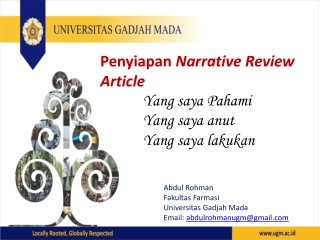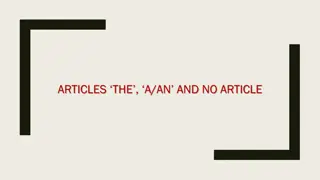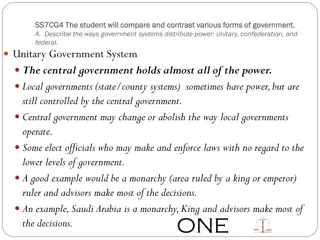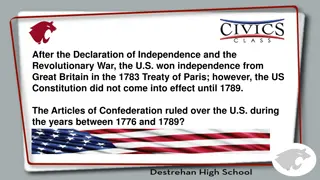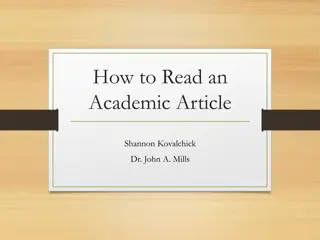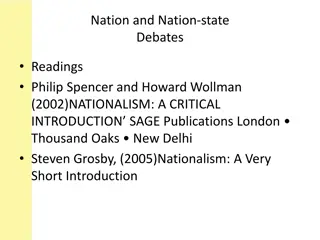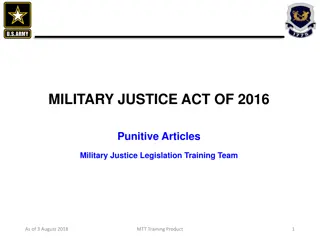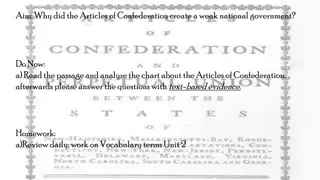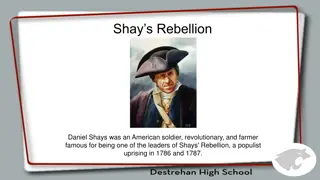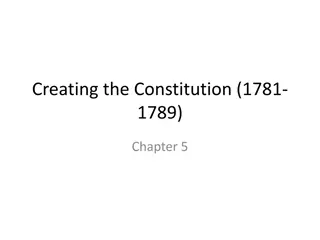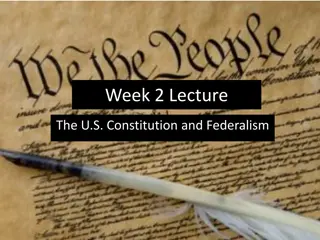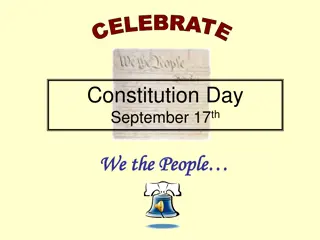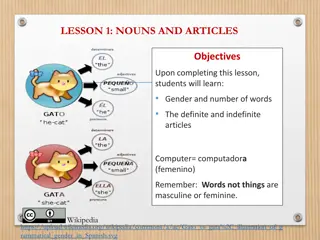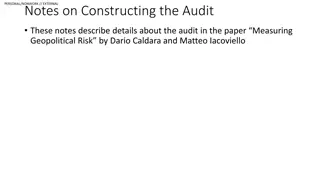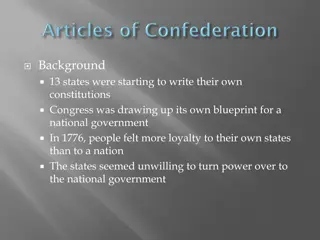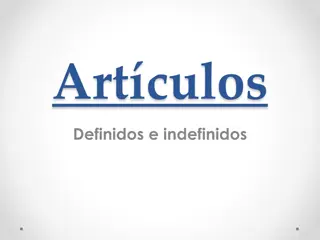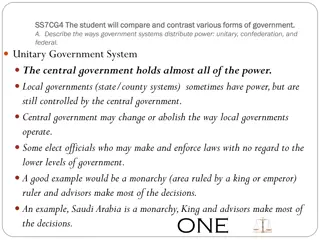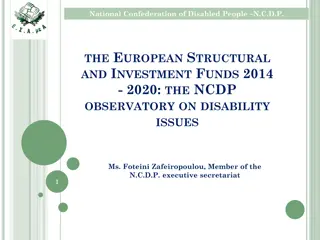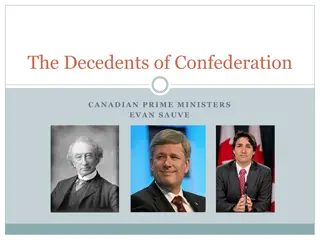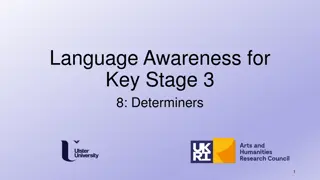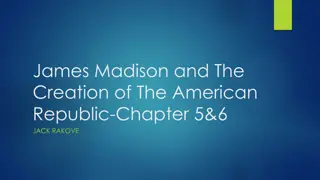Shaping a New Nation: Challenges of the Articles of Confederation
Americans initially adopted the Articles of Confederation as their first government, but soon realized its weaknesses. The lack of a strong central authority, debate over power distribution, limitations on the national government's powers, and challenges in governing newly acquired lands were key issues. The Northwest Ordinance of 1787 provided a framework for governing western lands. Despite the efforts, the nation grappled with the complexities of forming a cohesive government.
- Articles of Confederation
- Continental Congress
- Northwest Ordinance
- government challenges
- American history
Download Presentation

Please find below an Image/Link to download the presentation.
The content on the website is provided AS IS for your information and personal use only. It may not be sold, licensed, or shared on other websites without obtaining consent from the author. Download presentation by click this link. If you encounter any issues during the download, it is possible that the publisher has removed the file from their server.
E N D
Presentation Transcript
+ Chapter 5- Shaping a New Nation Bennett 2018-2019
+Main Idea Americans adopted the Articles of Confederation but soon found that it was too weak to solve the nation s problem. Articles of Confederation= our first government
+Debate over the new government No true central government The states had previously operated like independent countries. Only ties were winning the war States had all the power. Now they would be asked to give up power. NO ONE WILLINGLY GIVES UP POWER! Continental Congress was successful at managing the war effort but now what? Had no experience running a country
+Debates at the Continental Congress How would representation in the new government be determined? Representation: # of reps = votes. Votes = power What powers would the national government have and what powers would the states retain? How to settle newly acquired lands west of the Appalachian Mts. States were very different at the time and still are today: Big states vs. little states Populated states vs. non-populated states Wealthy states vs. poor states Slave states vs. free states.
+Articles of Confederation The document that set up the new government. Confederation = an alliance of the states.
+ National government under the AOC Powers: Declare war Make peace Sign treaties Borrow money Set standards for coins and measures Establish post offices Deal with Native Americans
+ National government under the AOC No power to: Create or collect taxes Coin money Fund an army or navy Enforce laws (no executive branch) Interpret laws (no judicial branch) Regulate interstate or foreign trade
+Northwest Ordinance of 1787 A way to decide how to govern lands west of the Appalachian mts. Congress would appoint governors and judges When 5,000 voting residents settled, they could write a temporary constitution. When they reached 60,000 they could write their own state constitution, which if approved by Congress would grant them statehood. *Provided a way for the country to expand.
+Shays Rebellion- 1786 Daniel Shays- veteran of the Revolutionary War Farmer, in debt (faced debtor s prison) 1,200 indebted farmers marched towards a federal arsenal in Springfield, Mass. State officials called out militia 4 people killed. Showed that the government LACKED POWER TO ENFORCE LAWS
+Shays Rebellion George Washington saw this an example of why we needed a stronger and more powerful national government.
+ George Washington- Shay s Rebellion Primary Source What does Washington say will happen if the government is unable to enforce its laws?
+ Why a new government? Articles Of Confederation were weak- could not raise an army, could not tax citizens. Britain and other European nations were still a threat. Government could not raise money States had all the power. Washington and Hamilton thought a stronger national government was necessary to protect itself. Remember, Britain and France are at this point much stronger countries than we were in the late 1700s.
+ Creating the Constitution
+ Constitutional Convention Philadelphia, Pennsylvania- 1787- original goal to make changes to the AOC Objective- to have a government that would protect life, liberty, and property. Problems from history- Madison studied other governments and concluded that no one government was perfect. They felt that Confederations of states were too weak to govern and collapsed from internal dissention. And stronger governments trampled on individual liberties.
+ The Constitutional Convention: Agreements and Compromises States sent 55 delegates to Philadelphia. Chose George Washington to preside over the meetings. Each state would have one vote on all decisions. Public and press were prohibited from attending. Agreed on representative government with 3 branches and to limit power of the states to coin money. (Separation of Powers)
+ The Virginia Plan Strong national legislature with two houses, upper and lower. Number of legislators per state would vary based on population. Strong executive, chosen by national legislature. National judiciary, chosen by the legislature. Smaller states opposed this plan because they wanted a less powerful government with more independence for the states.
+ The New Jersey Plan Small state counterproposal to Virginia Plan. Wanted a unicameral legislature with one vote for each state. Nation would continue as a confederation of states. Bitter debate between big states and small states almost brought an end to the convention.
+ The Great Compromise Bicameral legislature. House would be based on population Senate equal representation. Electoral college would determine the Presidency.
+ Disputes over Slavery Many Northern states wanted to abolish slavery Southern states would not accept the new government if it interfered with slavery. Resolution- no mention of slavery in the Constitution. How to count enslaved persons in matters of taxation and representation in congress. 3/5 Compromise- only 3/5 were to be counted for tax purposes and representation. Would last until 1868.
+ Convention part II Did not revise the articles, created an entire new government unlike any before it. Key questions facing the framers: What powers do the states retain? What powers should the federal government get? What about slavery? All these questions would be solved the way politics is still conducted today------Compromise!
+ Did the constitution set up a democracy? In short, no, they created a Republic or a government in which elected representatives make the decisions. Created some democracy (House of Representatives), left many issues to the states (federalism). Federalism- government authority shared by national and state governments.
+ Who s got the POWER? And how is it restricted? Article 1-Section 8 Enumerated powers- powers given to the national/federal government alone. Reserved powers- powers given to the states alone. Protected by the 10thAmendment. Concurrent powers- powers shared by the national and state governments.
+ State Governments
+States Rights Anti-federalists were concerned the new federal government under the constitution would have too much power. They pushed a bill of rights and more state control over laws. So the Constitution established a system called federalism where the power is shared between the national government and the states governments. All of the federal government s powers are listed in Article 1, Section 8 of the Constitution. These are called the enumerated powers. Anything not listed here is a power that is left to the individual states to decide. These are called the reserved powers.
+ Checks and Balances Separation of powers- constitutional authority is shared by three different branches of government. Theory proposed by the political philosopher Montesquieu. Each branch would keep the other from becoming too powerful. This would be a response to factions- a group with a distinct political interest.
+ override Can ____________ Presidents _______ veto Executive actions Can declare _______ unconstitutional Appoints ________ justices veto Can ______ laws Can declare act (laws) _______________________ unconstitutional Can _______________ and remove ____________ impeach justices
+ Legislative Branch Article I describes the legislative branch, aka the Congress. Includes: separation of powers, checks and balances, the election of representatives and senators, the process by which laws are made, and the powers that Congress has.
+ Section 8 Enumerated Powers- All the powers Congress has. Elastic Clause- stretches the power of Congress to make all laws necessary and proper.
+Federalism Power in the governments rests in both the national and state governments. Citizen of both the United States and New York State. National government is supposed to be limited in scope to certain Enumerated Powers. Why? States needed to retain powers or they would never accept or ratify the new Constitution.
+Why Federalism? The Framers were dedicated to the concept of limited government. They were convinced The governmental power poses a threat to individual liberty That therefore the exercise of governmental power must be restrained, and That to divide governmental power, as federalism does, is to curb it and prevent its abuse.
+Federalism Defined Federalism is a system of government in which a written constitution divides the powers of government on a territorial basis between a central, or national, government and several regional governments, usually called states or provinces. The Constitution provides for a division of powers, assigning certain powers to the National Government and certain powers to the States.
+Powers of the National Government The National Government is a government of delegated powers, meaning that it only has those powers delegated (granted) to it in the Constitution. There are three types of delegated powers: 1. The expressed powers are those found directly within the Constitution. 2. The implied powers are not expressly stated in the Constitution, but are reasonably suggested, or implied by, the expressed powers. 3. The inherent powers belong to the National Government because it is the government of a sovereign state within the world community. There are few inherent powers, with an example being the National Government s ability to regulate immigration.
+Powers Denied to the National Government Powers are denied to the National Government in three distinct ways: Some powers, such as the power to levy duties on exports or prohibit the freedom of religion, speech, press, or assembly, are expressly denied to the National Government in the Constitution. Also, some powers are denied to the National Government because the Constitution is silent on the issue. Finally, some powers are denied to the National Government because the federal system does not intend the National Government to carry out those functions.
+The States Powers Denied to the States Just as the Constitution denies many powers the National Government, it also denies many powers to the States. Powers denied to the States are denied in much the same way that powers are denied to the National Government; both expressly and inherently. Powers Reserved to the States The 10th Amendment declares that the States are governments of reserved powers. The reserved powers are those powers that the Constitution does not grant to the National Government and does not, at the same time, deny to the States.
+The Exclusive and Concurrent Powers Exclusive Powers Powers that can be exercised by the National Government alone are known as the exclusive powers. Examples of the exclusive powers are the National Government s power to coin money, to make treaties with foreign states, and to lay duties (taxes) on imports. Concurrent Powers The concurrent powers are those powers that both the National Government and the States possess and exercise. Some of the concurrent powers include the power to levy and collect taxes, to define crimes and set punishments for them, and to claim private property for public use.
+The Federal System and Local Governments There are more than 87,000 units of local government in the United States today. Each of these local units is located within on the 50 States. Each State has created these units through its constitution and laws. Local governments, since they are created by States, are exercising State law through their own means.
+The Division of Powers The federal system determines the way that powers are divided and shared between the National and State governments.
+The Supreme Law of the Land The Supremacy Clause in the Constitution establishes the Constitution and United States laws as the supreme Law of the Land.


